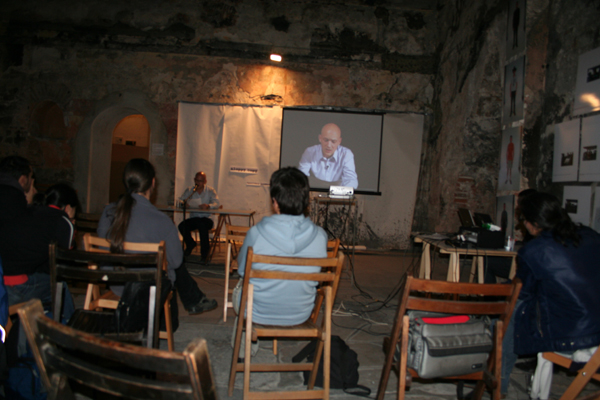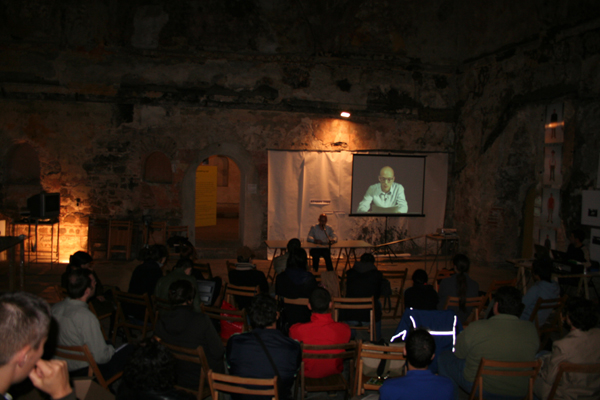home > projects and works > fake 2005 > the book - contents
- - - <performance> - <exhibition>
Imitate Yourself. A video lecture.

Today I’m going to talk about imitation: what happens when you imitate, and what happens when you imitate yourself.
Imitation and distortion
First let’s look at the basics: Imitation is a two-way process of distortion. So-called representation is a distortion of reality. So-called reality is a distortion of representation. The link between reality and representation is characterised by distortion.
You could state that distortion is something that is produced between reality and representation. In other words, distortion would be something which is created, and as something which is created it opens up that which is given. Distortion would thus allow us to re-negotiate naturalised states.
But for the purposes of our discussion I would like to emphasize that “distortion” is not something objective that happens to an original and that is related to and dependent on an original state. Forget the original state! Distortion is the space between the two poles of representation and reality. It is the space where these two poles meet.
In other words, in the final analysis, distortion precedes both representation and reality. It is only through distortion that things like reality and representation are possible in the first place. If constitutive distortion were not possible, I wouldn’t be able to give this presentation.
Counterpart /opposite number/ and politically motivated art
Now publics can recognise their counterpart /their opposite number/ somewhere other than in the representative model or in its actually present imitation. Because a counterpart /an opposite number/ is neither representation nor reality. Rather, the counterpart /the opposite number/ is present in the space between the two. This “space between” is the constitutive space of possibilities of distortion.
Now what does this mean in terms of the concept of politically motivated art? It means that such art enables a public to enter the double present of reality and representation, and to act in the space of possibilities. Such political work of art is therefore aware of its own constitutive distortion. It opens up the space between so-called reality and so-called representation. Only then can the work of art make the space between the two presents accessible to the public as an arena for micropolitical action.
But why only micropolitical? Because the concept of political art represented cannot extend into macropolitics – in other words the official politics of the state or nation. The only thing the concept of political art represented here can do is to provide a space of distortion where the public can create alternatives to the notions of official international, national or state politics.
The space of distortion must enable people like workers, unemployed, businesspeople, refugees, artists, service providers etc. to confront themselves. It does so by imitating or distorting various rhetorical means – images, gestures or the voice. The space of distortion enables the public to open up a space for itself as its own new counterpart /opposite number/ – between itself as a real public and itself as a represented public. Encounters between counterparts /opposite numbers/ are possible in the space of distortion.
You could say that this is a process that every work of art makes possible because it has the potential to stimulate the imagination. But it is difficult to find forms of distortion in which a public can recognise itself in different ways and wants to imitate itself. Because spaces that allow political action exist in the interplay of historically coincidental, contingent societies. The space of possibilities that a project opens up therefore depends on a public that dares to enter this space despite all the actual, accidental imponderables.

Chains of equivalence – entities that have potential for political manifestation
In terms of political theory, what we now have to do is connect images and signs to create the basis for new, committed languages: to create chains of equivalence and connection. When signs – whether they’re presented in the form of images, sounds, film, theatre or performance – are applied in both a new and a generalisable way, they can penetrate, connect and mobilise various social contexts in new ways. They then become signs of the distortion that intermediates between the signs of reality and the signs of representation.
“Spaces” and “chains of equivalence” presented in this way are designed to create thinkable and actable entities that have potential for political manifestation. So they stand in opposition to large political entities such as the nation, cultural associations, international political structures etc., and at the same time are still inscribed into them. In other words: Political effects in reality and in representation can be derived from the space of distortion.
For example, the notion of “political class” can re-enter general language use by means of jokes and word plays, and through this “influence” can raise awareness of the social and material basis of decisions. Going further, the notion of “class” can be taken from the context of the social sciences and connected with new terms from the language of the streets, TV advertising, death notices, soaps, technobabble, barbecuing etc. It thus creates a platform for an esoteric and almost private use of language that nevertheless formulates the potential for action and accumulation of knowledge.
For this reason, imitating yourself always means imitating the so-called peculiarity of your so-called own projects and presenting yourself as a new counterpart /opposite number/. Imitating yourself opens up the self and makes it permeable to chains of equivalence. Anyone who does not move in the space of distortion misses out on connections and is actually serving quite a different purpose: illustrating so-called reality or illustrating so-called representation – both of which are equally passive in political terms.